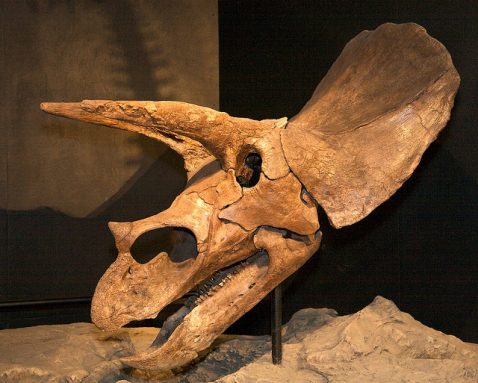Dino drama
Scientists study skulls to determine whether Triceratops and Torosaurus were two different species

In recent years, dinosaur experts have disagreed about Triceratops and Torosaurus, plant-eating dinos. Both are notable for sporting three horns on their heads. Some scientists have argued that there’s no reason to use both names. These researchers insist that both types of animals belong to the same genus. Triceratops are young versions of the dinos, they maintain, and Torosaurus the adult form.
But Torosaurus fans, take heart — and hold on to your horns. Torosaurus may belong to a separate genus that deserves its own name after all.
Nicholas Longrich and Daniel Field, both paleontologists at Yale University, analyzed a host of three-horned skulls representing both types. And they now report finding both youngster and grown-up examples of Triceratops. Paleontologists are scientists who study the remains of plants and animals that lived a long time ago to better understand life on Earth.
“I don’t see any clear fossil evidence that one dinosaur turned into the other,” Longrich told Science News. If correct, this would mean Torosaurus existed as a different animal.
Triceratops and Torosaurus lived at the same time, about 65 million years ago. Both types of dinos had three horns. Torosaurus had a wide piece of bone, called a frill, that extended behind its horns like a shield. The frill had two large holes in it. Triceratops lacked such a big headpiece; instead, the bone behind its horns was short and free of holes. Some scientists have argued that one type grew up to become the other.
Longrich and Field reasoned that if a Triceratops was just a young Torosaurus, then no skulls from an adult Triceratops or a young Torosaurus should exist. To find out, they studied 35 skulls and looked at the boundaries between different bones in the animals’ skulls. In some Triceratops skulls, they found examples where the bones had fused together, or become joined. That’s a sign that the skulls belonged to adults, and could be used to argue that grown-up Triceratops were different animals from Torosaurus.
However, as is often the case in dinosaur studies, what satisfies one paleontologist may not satisfy another. Paleontologist Jack Horner from Montana State University in Bozeman, for instance, has read about the new findings. And he still believes the two dino types belong to the same genus.
“We recently collected 100 new Triceratops specimens they haven’t seen,” Horner told Science News. And he doesn’t agree that finding fused bones in a Triceratops skull settles the debate: “We see a lot of variety in bone fusion.”
There is one kind of fossil that would go a long way toward proving Horner’s theory correct: A skull that’s partway between Triceratops and Torosaurus would indicate that one matured into the other. And Horner claims one has recently turned up.
But Longrich and others aren’t convinced. They think the unusual skull may have belonged to either a different type of animal or to a sick Triceratops.
Clearly, controversy on whether Torosaurus is a unique genus is far from over. “This is going to be discussed for years and years,” paleontologist Peter Dodson from the University of Pennsylvania in Philadelphia told Science News.
POWER WORDS (adapted from the New Oxford American Dictionary)
genus A group to which one or more related species belong.
paleontology The branch of science concerned with fossil animals and plants.
dinosaur A reptile of the Mesozoic era, which lasted from 245 million to 65 million years ago.
fossil The remains or impression of a prehistoric organism preserved in petrified form or as a mold or cast in rock.
skull The skeleton of a person’s or animal’s head.
frill An upward-curving bony plate extending behind the skull of some dinosaurs.







